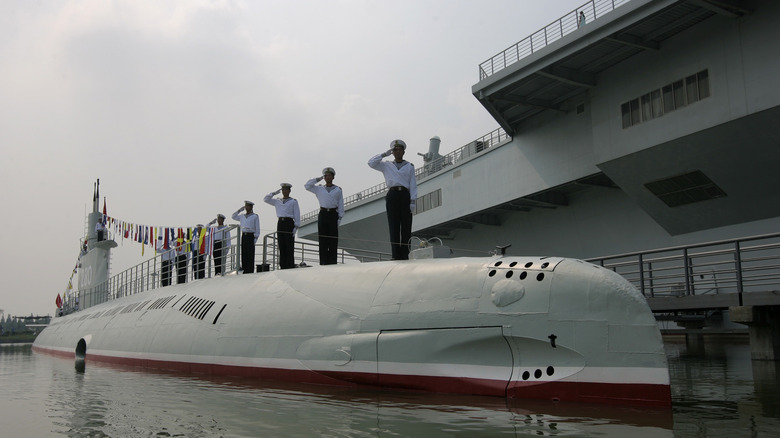How Many Nuclear Submarines Does China Have & How Does The US Navy Compare?
The more you read the news these days, the more things seem to be getting testy, with geopolitical tensions rising around the world. In the never-ending battle for superpower status, China seems to be keeping its foot on the gas, unleashing endless domestic infrastructure projects while shoring up its military and provoking neighbors. To ensure dominance in the South China Sea, East China Sea, and beyond, China employs a large array of naval vessels to patrol these waters.
Some are impressive and easy to spot, like its few aircraft carriers, sticking up high above the ocean's surface, while others lie deep beneath. China's People's Liberation Army Navy forces (PLAN) have a grouping of nuclear-powered submarines in its arsenal. These vessels are used both as a defensive measure and to maintain balance with American might, as its main rival.
China's current nuclear submarine fleet has been the product of a slow and steady buildup, comprised of both older and newer boats, believed to total 12. With rising tensions and provocations aimed at Taiwan, China's old imperial tendencies remain at the fore, as they seek to maintain a strong regional military presence — it's currently an interesting and potentially dangerous era in East Asian geopolitics.
Current fleet
During the second half of the 20th century, China expanded its submarine fleet, with a primary focus on diesel-electric variants. Then, in the early 1970s, China developed its first nuclear submarines, with the launch of the Type 091 (Han) class, later followed by the Shang class, in the early 2000s. While the exact number of nuclear subs China has remains somewhat of a mystery, thought to be around 12 as of 2024, there's no denying that the country is a superpower. Having the ability to deploy nuclear missiles from subs gives China a regional advantage.
To be able to do this, China's most advanced Type 094 sub carries a total of 12 JL-2 missiles with a range of 5,592 nautical miles. These Shang-class nuclear subs are 360 feet long, with a 36-foot beam, have a max speed of 30 knots, and are also able to launch anti-ship ballistic missiles with 248-mile ranges.
Comparatively, the U.S. Navy operates a substantially larger fleet of nuclear-powered subs, with 71 boats total in service. Within that, there are the Ohio, Los Angeles, Seawolf, and Virginia-class boats — all of which are nuclear-powered, with 14 being ballistic missile-capable, 53 attack subs, and four guided missile subs. Each class of American submarines can carry a variety of missiles, with Trident II and Tomahawk ballistic missiles at the ready. The former has a range of 6,500 nautical miles, while the latter can hit targets 1000 miles away. In sheer numbers, the U.S. outguns China.
Future plans
The U.S. Navy is amid a fleet reconfiguration, where it seeks to retire some of the Ohio-class boats soon, while onboarding newer Columbia-class subs, which can carry up to 16 Trident ballistic missiles. Another recent development in the sub program is the forthcoming sale of three Virginia-class subs to the Aussies, which will operate out of HMAS Stirling base, in Western Australia, for more firepower in the Indo-Pacific region. U.S. government officials (via Defense News) have stated on record that they want to swap out older subs and increase the fleet total to 66, but this won't become a reality until 2054, with an urgency to keep up with Chinese advancements.
Many officials seem weary of losing ground to their biggest rival in East Asia, held back by older subs. Meanwhile, China is maintaining a rapid and intentional advancement, threatening complete dominance of the surrounding seas, with impressive naval hardware technology. We can only hope future conflicts can be averted, but the balance of power in the region could tip towards China's favor, lest the U.S. optimize its fleet faster as old subs age out.
Beyond that, having enough crew has been an issue for American submarine fleets, with a drop in numbers post-pandemic. However, working with the Australian Navy, to help them expand operational capabilities, 50 nuclear-trained operators have recently graduated. Despite working with allies, the U.S. faces a distinct challenge against the sheer volume of Chinese forces, as they now claim the largest maritime fighting force in the world.


